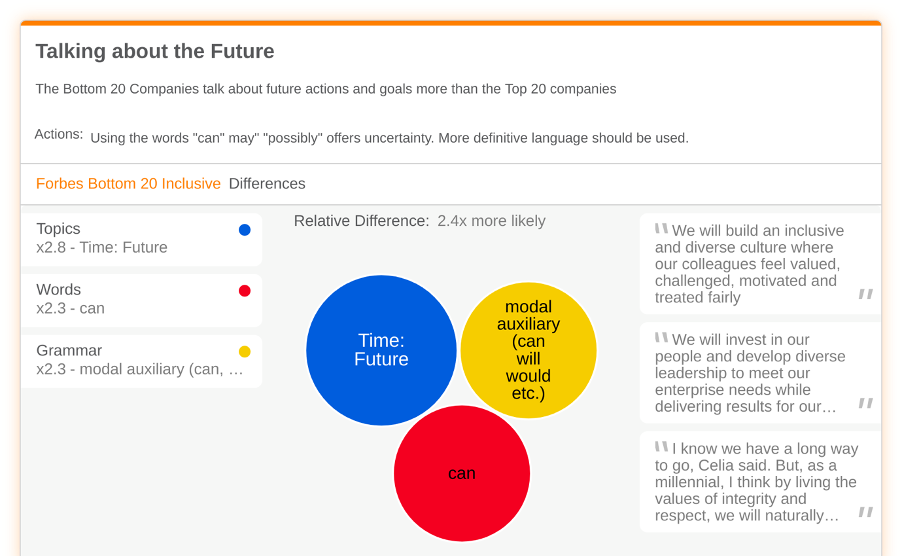How do organizations talk about their diversity and inclusion policies?

By Lizzie Atkinson
Since the death of George Floyd and the increased awareness of the Black Lives Matter movement, many large companies have been under scrutiny for their diversity and inclusion efforts, specifically when it comes to minority representations at director and leadership levels.
The use of language is hugely integral to what we do at Relative Insight, and so I thought it would be interesting to compare the language used by companies successfully celebrating diversity and inclusion compared to companies that are not as successful in doing so. During my research I was able to pick apart subtle biases and nuances in uses of language that have attracted and detracted the very best of talent, vendors and customers irrespective of their gender, race, ethnicity, religion, culture, social background, sexuality, disability or age.
Using Forbes 2020 list of America’s Best Employers for Diversity, I compared the language from the diversity and inclusion sections of each corporate website of each of the top and bottom 20 companies ranked in the list. Notable companies mentioned in the Forbes list include: #1 SAP, #2 Henry Ford, #3 P&G, #498 Nestlé, #499 Jacobs Engineering and #500 Bechtel.
It’s important to remember that despite being in the bottom 20 companies from this list, lots of these companies are still considered one of the top 500 American companies for diversity.
Using the Relative Insight text analysis platform, I compared their use of specific phrases, words, grammar, themes and emotion to see if there were any correlation on the language they used, and their rankings – here are my findings:
PEOPLE OF COLOUR REPRESENTATION:
In comparison to the bottom 20 companies, the top 20 ranked companies were 5.2x more likely to talk about BAME representations in the workplace, 2.6X more likely to talk about people of color in the workplace, and 4.8x more likely to mention minority groups.
As companies become more educated in understanding the importance of providing equal opportunities for minority ethnic groups and addressing the barriers to employee career progression for people of colour, it is likely we will see a positive change in these numbers.
EMPLOYEE RESOURCE GROUPS:
A significant similarity that I found between both groups was about their emphasis on the positive effects of employee resource groups – and here is an example from both groups:


QUANTITATIVE EVIDENCE:
The top 20 companies were 3.2X more likely to provide quantitative evidence of their diversity and inclusion efforts compared to the bottom 20 companies. Netflix (ranked at #14 in the Forbes list) is a notable example, because not only did they provide statistics for demographic breakdowns of the company as a whole, but also divulged numbers at a leadership level, and within the creative and tech functions too.
Quantitative evidence provides a transparent and truthful window into the changes that a company has made for its progression, recruitment strategies and diversity and inclusion programs. This evidence seems to be the greatest indicator between the top and bottom performing company groups in the Forbes list.
TALKING ABOUT THE FUTURE:
The bottom 20 companies were 2.3X more likely to use modal auxiliary verbs: can, will, would, may and might in their descriptions, but they were also 2.8X more likely to be talking in the future tense.
Giving indefinite plans could suggest that for companies in the bottom 20, diversity and inclusion agendas are not at the forefront of their priorities.

THEY:
In James W. Pennebaker’s book, The Secret Life of Pronouns, the author discusses what our words say about us. He warns us of the damaging implications of using the pronoun they to describe co-workers as opposed to we, us, I or you.
When talking about employees from minority and misrepresented groups using the word they, organisations unconsciously represent a disassociation with this group. By replacing the pronoun, they for we, I, or you in corporate comms, Pennebaker found that employees working for that company had a greater sense of fulfilment, and that the organisation had lower employee turnover and a better work ethic across the board.
My research proved this hypothesis to be true, and I found that the bottom 20 companies used the word they 2.5X more than the top 20 companies when talking about diversity and inclusion in the workplace.
FUTURE PREDICTIONS:
It will be interesting to see the changes made to the diversity and inclusion efforts of companies over the coming months and years as a result of recent anti-humanitarian actions and political protests, because no longer will companies be able to put diversity and inclusion initiatives on the back burner. They will be forced to think properly about their diversity and inclusion plans in order to sustain a positive brand reputation and fulfilled workforce.
Relative Insight can compare any language data set you can imagine, literally anything with words. Get in touch to see the platform in action .